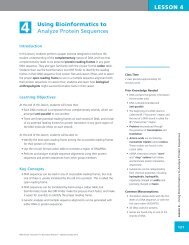WET LAB DNA Barcoding: From Samples to Sequences - Northwest ...
WET LAB DNA Barcoding: From Samples to Sequences - Northwest ...
WET LAB DNA Barcoding: From Samples to Sequences - Northwest ...
Create successful ePaper yourself
Turn your PDF publications into a flip-book with our unique Google optimized e-Paper software.
<strong>WET</strong> <strong>LAB</strong><br />
bases that are measured are produced by synthesizing new <strong>DNA</strong> in vitro, and might contain differences from the original<br />
sequence in the sample due <strong>to</strong> errors during <strong>DNA</strong> synthesis. Scientists use chroma<strong>to</strong>gram-viewing programs like FinchTV<br />
<strong>to</strong> view and analyze their chroma<strong>to</strong>grams and associated <strong>DNA</strong> sequence data. They use sequence assembly programs <strong>to</strong><br />
reconstruct a model of the original sequence. For more on <strong>DNA</strong> sequencing, see also Lesson Nine.<br />
<strong>DNA</strong> template: The <strong>DNA</strong> used as instructions <strong>to</strong> make more <strong>DNA</strong>, such as in PCR.<br />
Elute: To extract or remove one material from another, often by adding a solvent such as a buffer.<br />
Enzyme: A type of protein that catalyzes (increases the rate of) chemical reactions. For example, ATP synthase is an enzyme<br />
that catalyzes or facilitates the creation of ATP.<br />
Flow-through: Liquid that passes through a spin column in<strong>to</strong> the collection tube.<br />
Gel box: Apparatus in which an agarose gel is run.<br />
Golgi apparatus or Golgi body: A membrane-bounded cellular organelle that is involved in modifying proteins and<br />
transporting them <strong>to</strong> their final cellular destination.<br />
Lysis or “<strong>to</strong> lyse”: To break open.<br />
Lipids: Organic compounds that are non-polar; typically comprise the cell membrane.<br />
Molecular weight standard: Sometimes called a “molecular weight marker” or “<strong>DNA</strong> ladder” and abbreviated “MW,”<br />
this is a mixture of <strong>DNA</strong> fragments of known size used <strong>to</strong> identify the approximate size of a molecule run on a gel, using<br />
the principle that molecular weight is inversely proportional <strong>to</strong> migration rate through a gel matrix. Therefore, when used<br />
in gel electrophoresis, standards effectively provide a logarithmic scale by which <strong>to</strong> estimate the size of the other fragments<br />
(providing the fragment sizes of the standard are known). Standards are loaded in lanes adjacent <strong>to</strong> sample lanes before<br />
the run commences.<br />
No-cap collection tube: Type of microfuge tube used <strong>to</strong> hold a spin column and collect the flow-through.<br />
Nuclear membrane: Phospholipid bilayer that surrounds the nucleus.<br />
Nuclease: Type of enzyme that breaks down nucleic acids.<br />
Nuclease-free water: Water that does not contain nucleases. Often this water has been subjected <strong>to</strong> multiple rounds of<br />
purification, including being passed through a nano-filter. It is sometimes referred <strong>to</strong> as “nano-pure” or “ultra-pure” water,<br />
as it should contain only H 2<br />
O, with no dissolved salts or other contaminants.<br />
Using Bioinformatics: Genetic Research<br />
Nucleotide: Nucleotides are the building blocks of <strong>DNA</strong>. Each nucleotide contains a five-carbon sugar, a base, and a<br />
phosphate group attached <strong>to</strong> the 5’ carbon of the sugar. In <strong>DNA</strong>, the sugar is deoxyribose and the base can be adenine,<br />
cy<strong>to</strong>sine, thymine, or guanine. Note the 5’ and 3’ labels on the sugar molecule.<br />
346<br />
©<strong>Northwest</strong> Association for Biomedical Research—Updated Oc<strong>to</strong>ber 2012
















